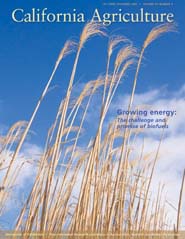All Issues

Growing energy:
The challenge and promise of biofuels
Cover:
Biofuels could reduce dependence on fossil fuels, but they also may affect the price and availability of food crops. Biomass crops will likely include fast-growing grasses like Miscanthus, which can be used dry (shown) or green. Photo by Don Hamerman, University of Illinois, Urbana-Champaign.
October-December 2009
Volume 63, Number 4
Volume 63, Number 4





